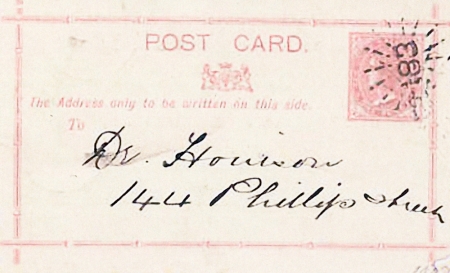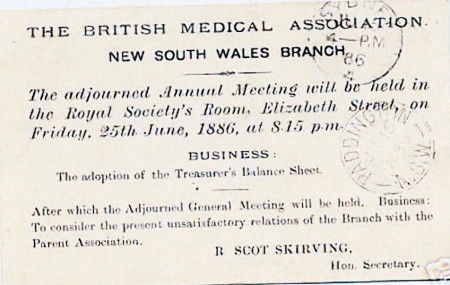This New South Wales postcard features two of Sydney’s prominent doctors in the latter half of the 19th and the early 20th centuries. It is addressed to Dr. Houison, 144 Phillip Street and the stamp is postmarked with ‘Rays’ 183 of Paddington, a suburb of Sydney (Figure 1).

The reverse has the following printing:
THE BRITISH MEDICAL ASSOCIATION.
NEW SOUTH WALES BRANCH
The adjourned Annual Meeting will be held in
the Royal Society’s Room, Elizabeth Street, on
Friday, 25th June, 1886, at 8.15 p.m.
BUSINESS:
The adoption of the Treasurer’s Balance Sheet.
After which the Adjourned General Meeting will be held. Business:
To consider the present unsatisfactory relations of the Branch with the
Parent Association.
R. Scot Skirving
Hon. Secretary
The originating postmark is shown as PADDINGTON/ JU 15/ 1886 and the arrival postmark is SYDNEY/ JU 1(-)/ 4– P.M./ 86/ 4 (Figure 2).

John McClymont starts his essay on Houison as follows: “What motivated Andrew Houison, a highly trained, successful medical practitioner, to develop a passion for Australian History and become the foundation president of the RAHS?” (Royal Australian History Society). Andrew was born in Parramatta on 1 January 1850 to his Scottish born parents, James and Ann (nee Stark) who raised 10 children, of whom Andrew was the youngest. The five sons, in particular were given a good education and Andrew entered Sydney University in 1866 and gained a BA degree in 1869. He followed his brother James to Edinburgh where he too graduated in medicine, M.B., Ch.M. (surgery).
Post graduate research in the medical field of antisepsis with Professor of Surgery Joseph Lister at the University of Edinburgh added significantly to his experience, but he declined the offer of a permanent research assistant to Lister, preferring to marry and return to Sydney. After a year in private practice in Macquarie Street, he accepted the position of Secretary to the NSW Medical Board. In this prestigious position, Houison became well known in medical and government circles in Sydney.
He pursued post graduate research in the medical field of antisepsis with Professor of Surgery Joseph Lister at the University of Edinburgh, added significantly to his experience but he declined the offer of a permanent research assistant to Lister, preferring to marry and return to Sydney. After a year in private practice in Macquarie Street, he accepted the position of Secretary to the NSW Medical Board. In this prestigious position, Houison became well known in medical and government circles in Sydney.
His abiding hobby was philately, influenced by collecting stamps from his family’s overseas correspondence. He became president of both the NSW and Australian Philatelic Associations. His researches into the early history of the ‘Postage Stamps, Envelopes and Post Cards in Australia’ led to correspondence with the Philatelic Society of London. With the approaching 50th anniversary of the introduction of the Postage Stamps in Great Britain in May 1890, Houison conceived the idea of an Australian component to the planned exhibition. Houison undertook the research with the help of the Government Printer, and within a month or so the display was prepared and dispatched to London. The display resulted in a prestigiously printed and prepared illustrated book, The History of the Post Office of New South Wales, completed by March 1890 with Houison credited as author. Houison died in 1912.
Robert Scot Skirving, physician and surgeon, was born on 18 December 1859 at Camptown, Haddington, Scotland, son of Robert Scot Skirving, farmer, and his wife Elizabeth, daughter of William Owen, squire of Ekindale, Ireland.. He entered the merchant service and, after two voyages to Iceland, joined the training ship Conway, and was apprenticed in 1875 in a sailing vessel, Tantallon Castle, bound for Port Adelaide.
On the return voyage Scot Skirving developed beri-beri, which led him in 1876 to enrol in medicine at the University of Edinburgh (M.B., Ch.M., 1881). After further studies in Dublin and Vienna he was appointed house physician at the Royal Infirmary, Edinburgh, in 1881. In 1883 Scot Skirving joined the migrant ship, Ellora, as ship’s surgeon and returned to Australia, where he practised in Queensland until appointed medical superintendent at (Royal) Prince Alfred Hospital, Sydney. In 1884 he set up practice in College Street and on 6 January 1886 at Willoughby he married Lucy Susan Hester (d.1950).
He was successively honorary assistant physician (1884-89), honorary physician (1889-1911) and consultant from 1911 at R.P.A.H. He was also an able surgeon and was honorary surgeon at St Vincent’s Hospital (1889-1923). He was the lecturer in clinical medicine at the University of Sydney (1889-1911), and was president of the New South Wales branch of the British Medical Association (1891-92). As a clinician, Scot Skirving was greatly celebrated. A handsome man, with aquiline features, he was a popular teacher and an accomplished, if somewhat flamboyant, lecturer, illustrating his points with amusing anecdotes. He served in the South African War as consulting surgeon (1900-01).
In England on the outbreak of World War I, Scot Skirving served as a major in the Royal Army Medical Corps, for three months in charge of an auxiliary hospital in Essex, then as surgeon specialist at Queen Alexandra Military Hospital, Millbank, London. He returned to Sydney in January 1919. Scot Skirving published extensively on medical subjects in the Australian Medical Gazette and the Medical Journal of Australia. His speech, uttered in a deep, rich voice, reflected both the Bible and his saltier experiences in the merchant marine
It was rare for ‘a man to practice as a specialist surgeon at one hospital and as a specialist physician at another’. He was proud to be a foundation fellow of both the (Royal) Australasian College of Surgeons (1927) and of the Royal Australasian College of Physicians (1938) and an honorary fellow of the Royal College of Surgeons, England (1953). Scot Skirving died at his Bellevue Hill home on 15 July 1956 and was cremated. He was survived by one of his three sons. Scot Skirving’s estate was valued for probate at £213,817 in two States. His name is commemorated at the University of Sydney by a prize in medicine and surgery.
The information on Huison is extracted from the Royal Australian History Society website, and that for Scot Skirving from the Australian Dictionary of Biography website.